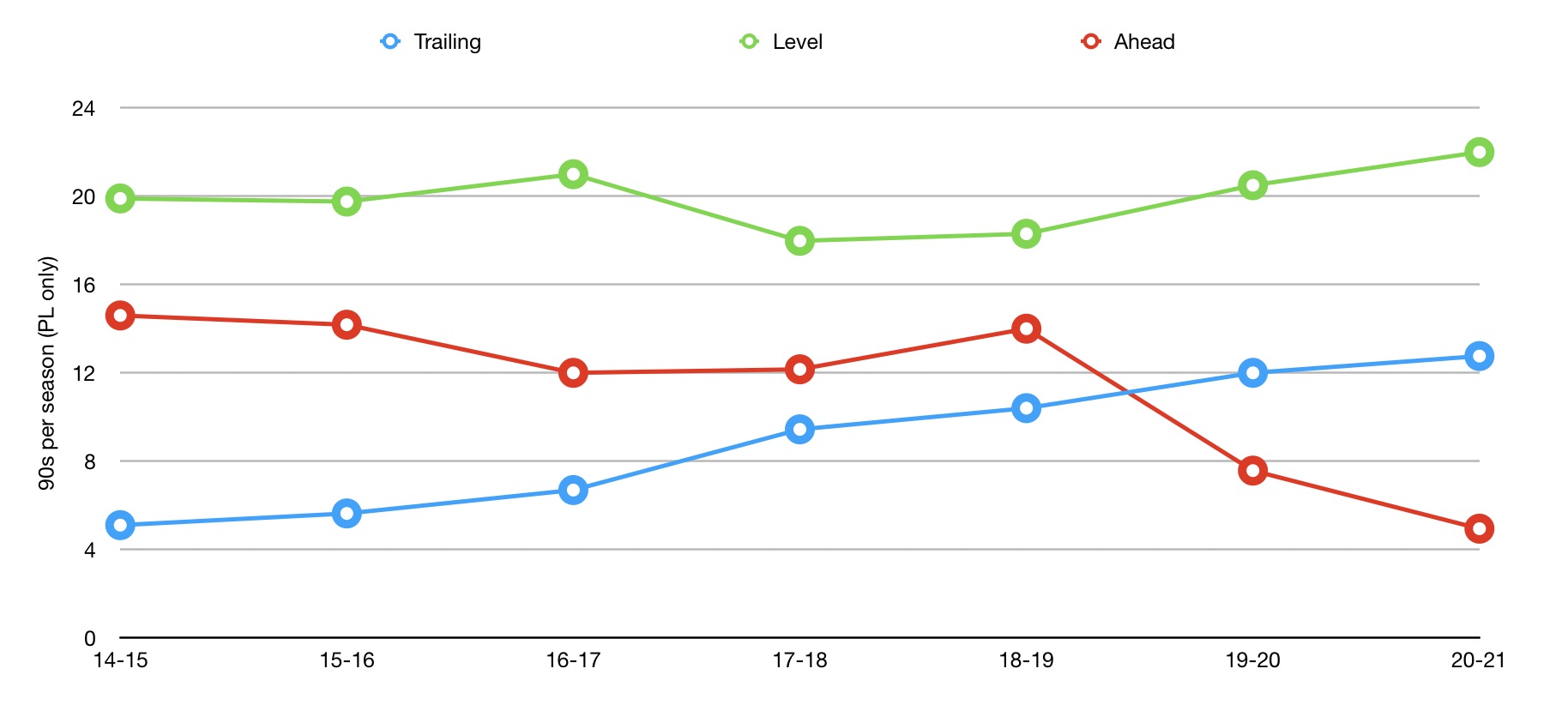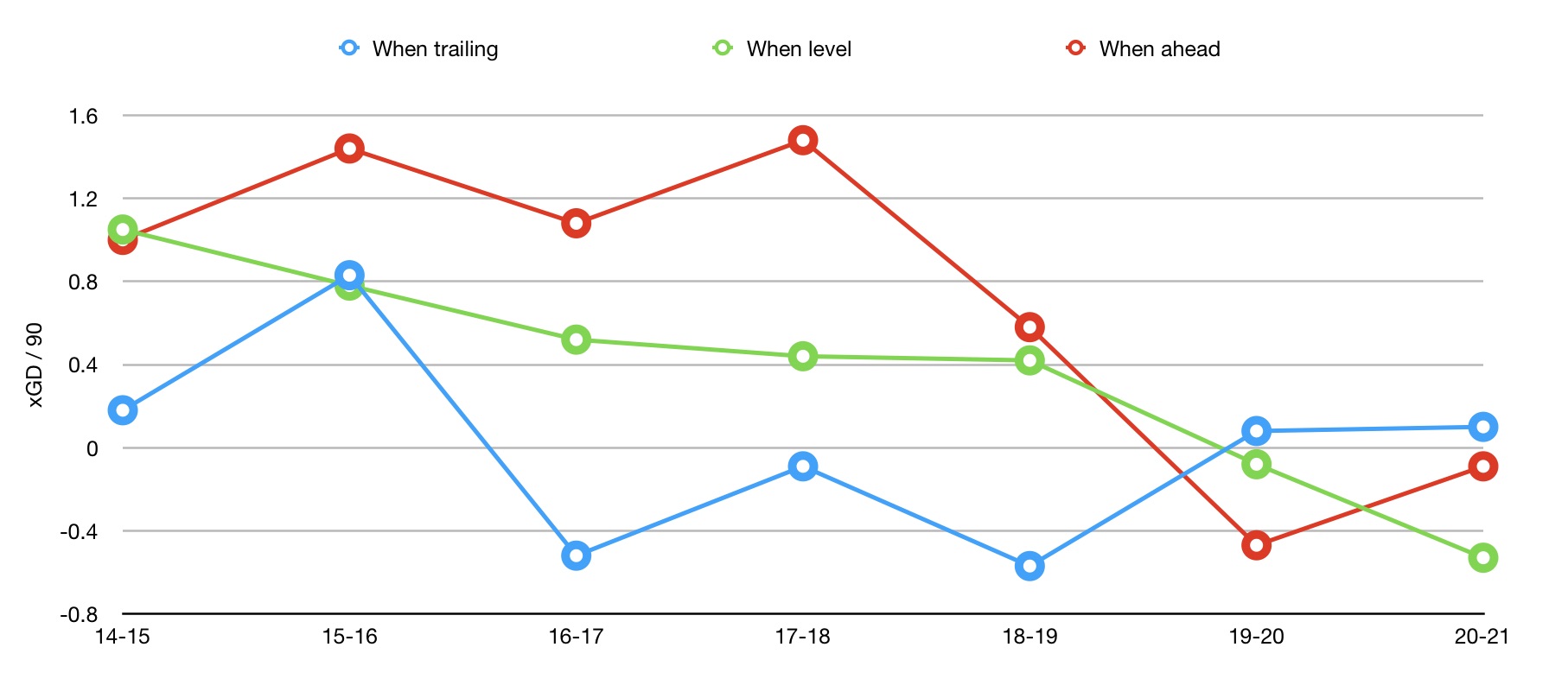You can be trailing, level, or leading in a football match. Of those three, it’s pretty obvious that being ahead is best and being behind is worst. But Arsenal have, in their last 10 Premier League games, only been ahead for under half an hour and behind more than a third of the time.
Did the Gunners deserve to lose to Tottenham and Everton? According to Mikel Arteta and his reading of expected goals, no, not really. “Last weekend [against Everton] it was a 67% chance of winning and a 9% chance of losing, and you lose,” Arteta said in a recent press conference. “And 7% against Spurs, and you lose. If you are constantly in the 60s and 70s long-term, you are going to win many more matches and this is what we have to try to do.”
But is it really true that Arsenal had just a 7% chance of losing to Spurs? Based on the shots the teams had, maybe. At least that’s what the models used by the club suggest. But in reality, Arsenal trailed for the majority of the game. Spurs’ lead at the break wasn’t undeserved, they were clinical to be two goals ahead, but the scoreline informed the second half.
Tottenham Hotspur 2 (0.35) – Arsenal 0 (0.54) pic.twitter.com/QsmZ40JEKV
— Scott Willis (@oh_that_crab) December 6, 2020
Tottenham, safely ahead, stopped attacking. Jose Mourinho admitted as much in his post-match press conference. The onus was entirely on Arsenal to score. Is it an accident that Arsenal keep finding themselves level or behind? Well, no. In every single season from 2014/15 on, Arsenal have spent more and more time trailing. The last two seasons have been particularly concerning, because the team has actually spent more time behind than in the lead. This isn’t quite the picture Arteta is painting when he suggests things will turn around.
 (The above graph stretches out 2020/21 so far as if it were a 38-game season.)
(The above graph stretches out 2020/21 so far as if it were a 38-game season.)
Arsenal are struggling to dominate the shots when games are level, which means they end up behind. From there, the Gunners actually do dominate the shot count, but this is likely to be happening more and more as teams grow increasingly comfortable with the idea that Arsenal can’t create much against defensive sides.
Compared to 2014-2018, when Arsenal managed to out-shoot opponents regardless of game state, the Gunners were out-shot when behind or ahead in 2018/19, in all three situations last season, and are being out-shot more than ever when games are level in 2020/21 so far.
 While Arsenal are managing more shots when behind, they aren’t really racking up an advantage when it comes to expected goals, because the vast majority of the shots are poor. See how that blue line has jumped up from last season when it comes to shots but stays flat when it comes to expected goals.
While Arsenal are managing more shots when behind, they aren’t really racking up an advantage when it comes to expected goals, because the vast majority of the shots are poor. See how that blue line has jumped up from last season when it comes to shots but stays flat when it comes to expected goals.
 Arsenal are dominating the shot count but aren’t actually more likely to score than the opponent, creating just 0.1xG more than the opposition (per 90 minutes) when behind.
Arsenal are dominating the shot count but aren’t actually more likely to score than the opponent, creating just 0.1xG more than the opposition (per 90 minutes) when behind.
At some point in 2018, it seems, Arsenal changed. All three graphs agree on that. Arsenal used to out-shoot their opponents, on average, regardless of the score and outdo them pretty convincingly on xG when level or ahead too. It’s safe to assume the issues with the expected goal difference when trailing in Arsene Wenger’s final seasons came largely because Arsenal were frequently completely and convincingly outdone by the top teams, who would take the lead and then run away with games, and because the team struggled to create anything away from home without being exposed on the break. Even then, the side spent much less time behind than they do now. Perhaps the turning point was the sale of Alexis Sanchez, who both took and created shots at an elite level.
Whatever it was, it’s clear something broke around that point. Until then, Arsenal were a side that were in front more than they were behind, out-shot their opponents regardless of game state, and racked up an expected goals advantage as long as they weren’t behind. Whenever Arsenal weren’t losing, they were likely to win.
Since the start of 2019/20, Arsenal actually, incredibly, spend more time trailing than they spend in the lead. The side are out-shot when level and when ahead, and they take a hit on expected goals when they aren’t trailing.
Whereas Wenger’s teams were encouraged to play their way, all the way, it seems Emery and Arteta have leaned more heavily into not falling behind when level, or not being pegged back when ahead. Those constraints (and some questionable transfer business leading to a lack of creative talent) have taken their toll on the side, which is now not built to take the lead in games, not likely to hold onto the lead when it does have one, and doesn’t have the ability to fire itself back into a match.
The problems run deep in north London and Arteta, perhaps unwittingly, has actually just brought another one under the microscope with his suggestions that everything is going to be just fine and that the rub of the green is the only thing working against his side.
As long as Arsenal don’t find away to dominate games when scores are level, they will keep falling behind.


